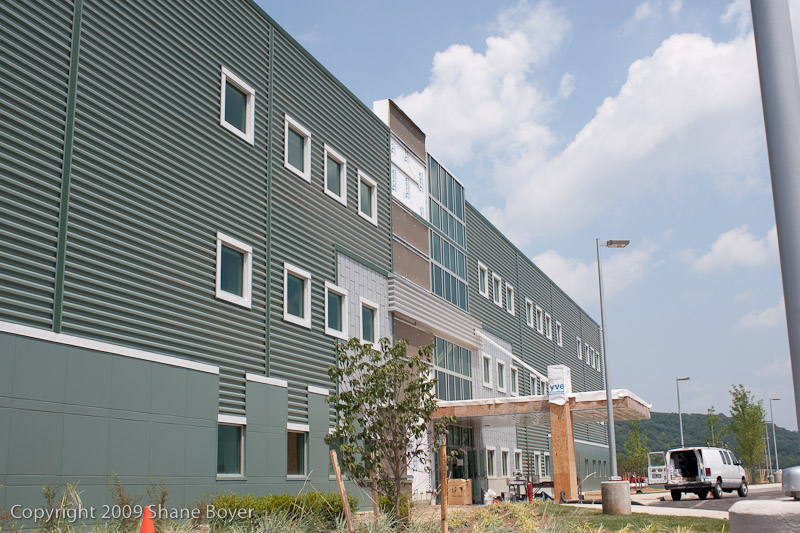The Buckhorn Medical Office Building
GEISINGER HEALTH SYSTEMS
BLOOMSBURG, PA

| Home |
| Biography |
| Building Statistics |
| Thesis Abstract |
| Technical Assignments |
| Thesis Research |
| Thesis Proposal |
| Presentation |
| Final Report |
| Reflection |
| Senior Thesis e-Studio |
Note: While great efforts have been taken to provide accurate and complete information on the pages of CPEP, please be aware that the information contained herewith is considered a work-in-progress for this thesis project. Modifications and changes related to the original building designs and construction methodologies for this senior thesis project are solely the interpretation of Shane Boyer. Changes and discrepancies in no way imply that the original design contained errors or was flawed. Differing assumptions, code references, requirements, and methodologies have been incorporated into this thesis project; therefore, investigation results may vary from the original design. |
GENERAL BUILDING STATISTICS |
|
Building Name
|
Buckhorn Medical Office Building
|
|---|---|
Building Occupant
|
Geisinger Health Systems
|
Location and Site
|
240 Mall Boulevard
|
Bloomsburg, PA 17815 |
|
Size
|
83,245 sf. (Building) 543,299 sf. (Site)
|
Number of Stories
|
(3) Three Above Grade |
PRIMARY PROJECT
|
TEAM |
Building Owner
|
Geisinger Health Systems - Facilities Administration |
Architect
|
Borton-Lawson |
Construction Manager
|
Alexander Building Construction |
MEP
|
Borton-Lawson |
Civil Engineer
|
Borton-Lawson |
LEED Advisor
|
7 Group |
Dates of Construction
|
December 2007 - October 2009 |
Project Cost
|
$11.7 million for overall project cost |
Project Delivery Method
|
Design-Bid-Build |
Building Codes/Standards
|
International Building Code 2006 (IBC) |
Zoning
|
Business (3B) |
Building Facades |
The Buckhorn Office Building uses a curtain wall system comprised of several different materials. The majority of the façade is comprised of a metal panel system using 5 different colors of panels. The panels come in 4’ x 4’ sections and are attached to an underlying EIFS backing system. The metal panels are accompanied by rigid metal paneling that is constructed in 25’ increments and covers the top two-thirds of the building. This rigid metal paneling is also attached to the skin of the building via an underlying EIFS backing system. Along with metal panel construction, there is an architectural feature located at the front entryway that uses a more complex curtain wall layout comprising of metal panels, anodized aluminum mullions and glazing. The glazing used for the curtain wall is insulated and tinted. The glazing is provided by Atlantica and is Low E glazing. This curtain wall feature runs vertically from the front entrance to the roof. |
Roofing |
The roofing system used on the Buckhorn Office Building is a single-ply, fully adhered system. There is 1 roof hatch for rooftop access and 4 HVAC rooftop units that sit on the roof. As per the owner’s request, 24”x24” composite rubber tiles have been placed as a pathway from the roof hatch to the RTU’s to prevent falling as well as roof damage for maintenance personnel. |
Sustainability Features |
Although the Buckhorn Office Building is undergoing the LEED process of becoming a Silver rated building, many of the LEED credits are being obtained through the construction management process, not so much of the design process. However, the mechanical engineer incorporates high-efficiency heat pumps, furnaces, and cooling tower to reduce building operational costs. |
Construction |
The Buckhorn Medical Office Building is being delivered as a design-bid-build method with a CM-At-Risk. The contract is a very typical Guaranteed Maximum Price (GMP) job where the construction manager, Alexander Building Construction, holds the contracts for all of the subcontractors. The architect, Borton-Lawson Engineering and Architecture, was hired directly by the owner, Geisinger Health System, and works with the construction manager but is not legally bound to them. The construction manager runs the day-to-day management of the project and the owner will release the payments on a monthly basis. It should also be noted that although this is a GMP with a CM-At-Risk, there is no owner representative. Geisinger has a specific construction and facilities management division that is responsible for all of the company’s capital projects. Because Geisinger does a lot of construction in the northeast Pennsylvania area, they provide a list of pre-approved subcontractors for the construction manager. This list is continually updated by Geisinger, and the construction manager is required to first choose subcontractors from the pre-approved list for bidding. If the construction manager deems that no subcontractor is fit for the job, they are allowed to submit a subcontractor for Geisinger to approve. Each of the major bid packages uses a closed bidding system. Subcontracts are awarded based on value of bid and not purely on lowest cost. Being a private building contract, the construction manager is not required to use the lowest bid, and Geisinger is heavily involved in the subcontractor selection process. As the construction manager, Alexander Building Construction uses a typical insurance coverage policy. Alexander holds a $1 million general liability, $1 million automobile liability, $10 million umbrella policy, and $500,000 worker’s compensation policy. For the project, the construction manager is not required to furnish bonds according to Section 8.3.1 of the Standard Form of Agreement Between Owner and Construction Manger. |
Electrical |
The Buckhorn Medical Office Building gets its power from two 5-inch concrete encased PVC Schedule 40 conduits that enter the site from the southwest. The power is stepped down to 480Y/277V in a transformer installed and provided by PPL outside the building. The lines run underground into the main electrical room and main switchboard located in the northwest corner of the building. The power is then run through the building at 480Y/277V and is stepped down to 208Y/120V using eight transformers. Most of the lighting is powered by 277V and is not stepped down from the initial transformer. There are 26 panelboards located throughout the building for receptacles, lighting, and other various pieces of equipment. A 125 kVA, 480Y/277V diesel generator is located in a weatherproof, sound attenuating outdoor enclosure with an eight-hour fuel tank next to the main transformer. This generator serves to power approximately 1-in-12 light fixtures in open office areas and at least one light fixture in individual offices and other confined spaces. There are also two panelboards powered by the emergency generator. These panelboards purely supply power to the emergency lighting. |
Lighting |
There are 34 different lighting fixtures used in the Buckhorn Office Building. The primary lighting system used in the Buckhorn Office Building consists of 2'x4' Prismatic Fluorescent 2-Lamp fixtures by Metalux. These fixtures are used in the open office floor spaces. In the closed office spaces, there are 2'x2' Prismatic Fluorescent 2-Lamp fixtures. All fluorescent fixtures use a standard T8 32W lamps. Interspaced with the 2-lamp fixtures are 3-lamp fixtures that double as the emergency lighting system. In the elevator lobbies and the main entrance lobby, five different architectural lighting fixtures are provided by American Glass Light. In the main entrance lobby there are 6" recessed fluorescent hi hats that use an 18W quad lamp. In all unfinished areas (mechanical rooms, etc.), 4' and 8' industrial fluorescent fixtures by Metalux are suspended from the above metal decking. T8 32W lamps are used |
Mechanical |
The mechanical system of the Buckhorn Medical Office Building is a water-cooled heat pump system. On each floor there are approximately nine 950 CFM water-cooled heat pumps located above the ceiling spaced throughout the open office areas. On each floor, there are three mechanical rooms that each contain two 2000 CFM heat pumps. On the roof, there are four roof top energy recovery heat pump units that produce 22,000 CFM combined. The main mechanical room, located in the northwest corner of the building, houses three 880 MBH gas-fired boilers as well as four 600 GPM closed-coupled circulating pumps that service the building’s heat pumps and cooling tower. The cooling tower, located just outside of the mechanical room, produces 600 GPM. Located between the circulating pumps and the cooling tower is a 600 GPM, 215 plate, 2,291.71 SF plate and frame heat exchanger. The heating and cooling for the building is distributed almost 100% all air from the individual heat pumps and root top units. Each unit is also connected to a cold water supply and return from the main cooling tower. |
Structural |
Structural Steel Frame The crane being used for all steel placement is a Kobelco CK850-III hydraulic crawler crane with a maximum lift capacity of 75 tons and a max boom length of 200 feet. The crane starts by placing all of the columns and then works from west to east placing all of the girders and then again placing all of the beams. Due to the low total height of the building (43’-0”) there are no logistical issues placing any pieces of steel with the provided crane. No additional overhead protection is necessary due to the size of the site during crane picks. Cast-in-Place Concrete |

This Page was last updated on October 12, 2009 by Shane Boyer and is hosted by the AE Department© 2009. |
|---|